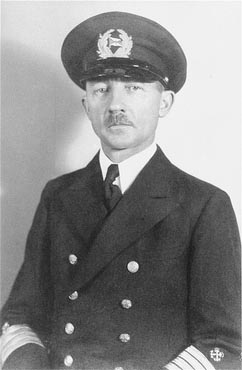On May 13, 1939, the German transatlantic liner St. Louis sailed from Hamburg, Germany, for Havana, Cuba. On the voyage were 938 passengers, one of whom was not a refugee. Almost all were Jews fleeing from the Third Reich. Most were German citizens, some were from Eastern Europe, and a few were officially “stateless.”
The majority of the Jewish passengers had applied for U.S. visas, and had planned to stay in Cuba only until they could enter the United States. But by the time the St. Louis sailed, there were signs that political conditions in Cuba might keep the passengers from landing there. The U.S. State Department in Washington, the U.S. consulate in Havana, some Jewish organizations, and refugee agencies were all aware of the situation. The passengers themselves were not informed; most were compelled to return to Europe.
Since the Kristallnacht (literally the “Night of Crystal,” more commonly known as the “Night of Broken Glass”) pogrom of November 9-10, 1938, the German government had sought to accelerate the pace of forced Jewish emigration. The German Foreign Office and the Propaganda Ministry also hoped to exploit the unwillingness of other nations to admit large numbers of Jewish refugees to justify the Nazi regime’s anti-Jewish goals and policies both domestically in Germany and in the world at large.
The owners of the St. Louis, the Hamburg-Amerika Line, knew even before the ship sailed that its passengers might have trouble disembarking in Cuba. The passengers, who held landing certificates and transit visas issued by the Cuban Director-General of Immigration, did not know that Cuban President Federico Laredo Bru had issued a decree just a week before the ship sailed that invalidated all recently issued landing certificates. Entry to Cuba required written authorization from the Cuban Secretaries of State and Labor and the posting of a $500 bond (The bond was waived for U.S. tourists).
The voyage of the St. Louis attracted a great deal of media attention. Even before the ship sailed from Hamburg, right-wing Cuban newspapers deplored its impending arrival and demanded that the Cuban government cease admitting Jewish refugees. Indeed, the passengers became victims of bitter infighting within the Cuban government. The Director-General of the Cuban immigration office, Manuel Benitez Gonzalez, had come under a great deal of public scrutiny for the illegal sale of landing certificates. He routinely sold such documents for $150 or more and, according to U.S. estimates, had amassed a personal fortune of $500,000 to $1,000,000. Though he was a protégé of Cuban army chief of staff (and future president) Fulgencio Batista, Benitez’s self-enrichment through corruption had fueled sufficient resentment in the Cuban government to bring about his resignation.
More than money, corruption, and internal power struggles were at work in Cuba. Like the United States and the Americas in general, Cuba struggled with the Great . Many Cubans resented the relatively large number of refugees (including 2,500 Jews), whom the government had already admitted into the country, because they appeared to be competitors for scarce jobs.
Hostility toward immigrants fueled both antisemitism and xenophobia. Both agents of Nazi Germany and indigenous right-wing movements hyped the immigrant issue in their publications and demonstrations, claiming that incoming Jews were Communists. Two of the papers–Diario de la Marina, owned by the influential Rivero family, and Avance, owned by the Zayas family, had supported the Spanish fascist leader General Francisco Franco, who, after a three-year civil war, had just overthrown the Spanish Republic in the spring of 1939 with the help of Nazi Germany and Fascist Italy. Reports about the impending voyage fueled a large antisemitic demonstration in Havana on May 8, five days before the St. Louis sailed from Hamburg. The rally, the largest antisemitic demonstration in Cuban history, had been sponsored by Grau San Martin, a former Cuban president. Grau spokesman Primitivo Rodriguez urged Cubans to “fight the Jews until the last one is driven out.” The demonstration drew 40,000 spectators. Thousands more listened on the radio.
When the St. Louis arrived in Havana harbor on May 27, the Cuban government admitted 28 passengers: 22 of them were Jewish and had valid U.S. visas; the remaining six-four Spanish citizens and two Cuban nationals–had valid entry documents. One further passenger, after attempting to commit suicide, was evacuated to a hospital in Havana. The remaining 908 passengers (one passenger had died of natural causes en route)–including one non-refugee, a Hungarian Jewish businessman-had been awaiting entry visas and carried only Cuban transit visas issued by Gonzales. 743 had been waiting to receive U.S. visas. The Cuban government refused to admit them or to allow them to disembark from the ship.
After Cuba denied entry to the passengers on the St. Louis, the press throughout Europe and the Americas, including the United States, brought the story to millions of readers throughout the world. Though U.S. newspapers generally portrayed the plight of the passengers with great sympathy, only a few journalists and editors suggested that the refugees be admitted into the United States.
On May 28, the day after the St. Louis docked in Havana, Lawrence Berenson, an attorney representing the U.S.-based Jewish Joint Distribution Committee (JDC), arrived in Cuba to negotiate on behalf of the St. Louis passengers. A former president of the Cuban-American Chamber of Commerce, Berenson had had extensive business experience in Cuba. He met with President Bru, but failed to persuade him to admit the passengers into Cuba. On June 2, Bru ordered the ship out of Cuban waters. Nevertheless, the negotiations continued, as the St. Louis sailed slowly toward Miami. Bru offered to admit the passengers if the JDC posted a $453,500 bond ($500 per passenger). Berenson made a counteroffer, but Bru rejected the proposal and broke off negotiations.
(In US weren’t accepted either)…
Sources: Holocaust Memorial/INternetPhotos/TheCubanHistory.com



 Cuban History: The Voyage of the St. Louis
Cuban History: The Voyage of the St. Louis
